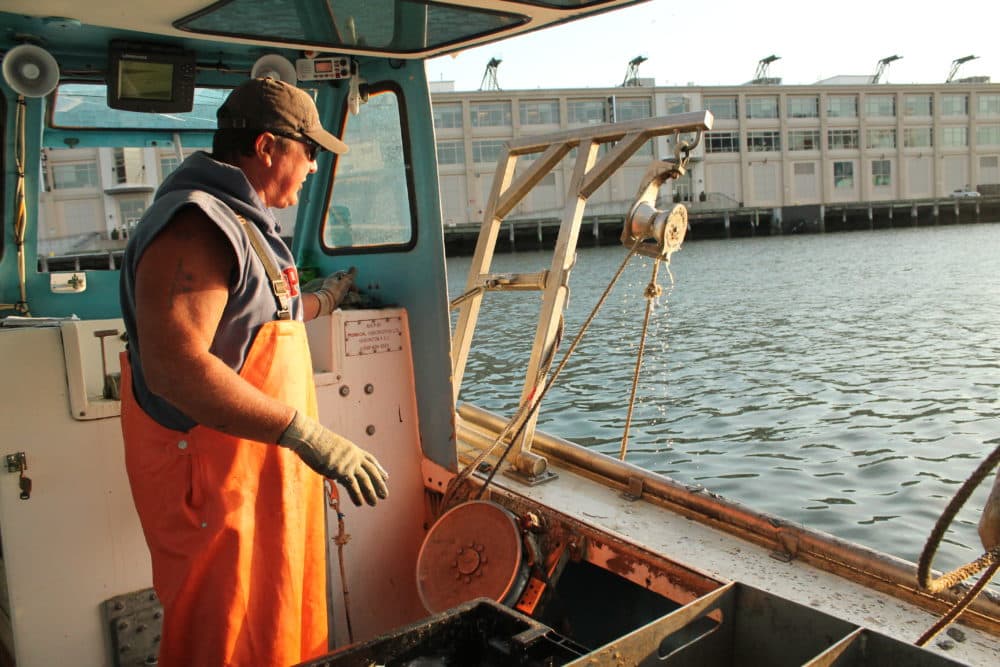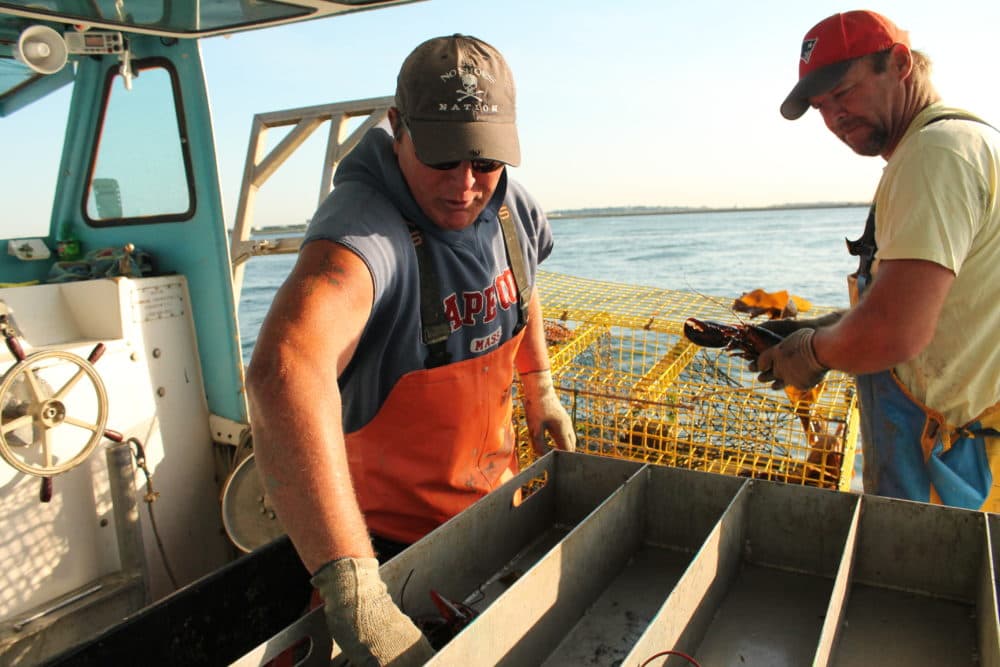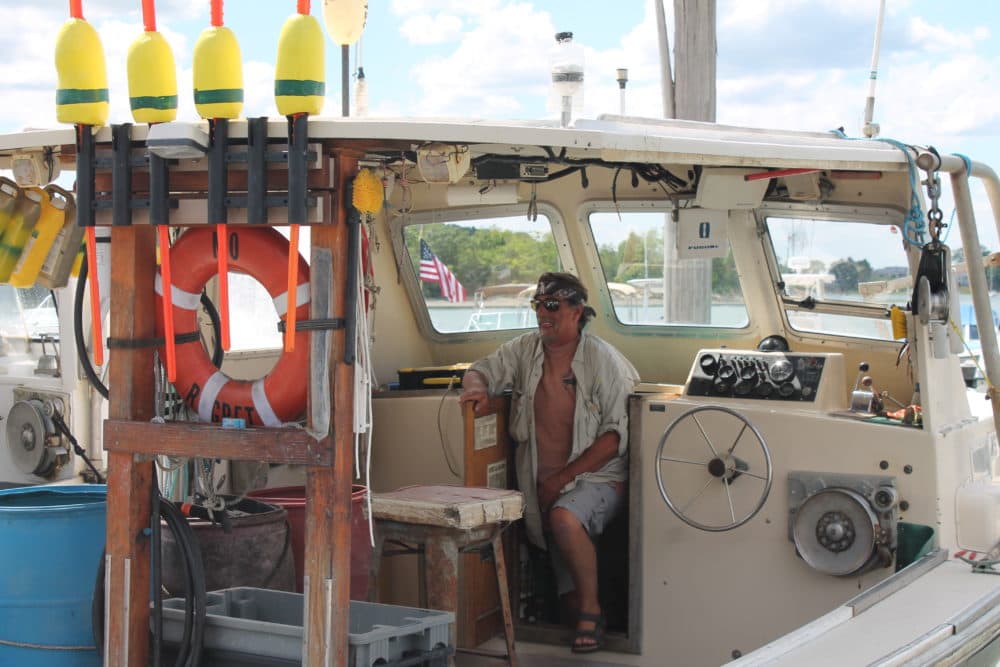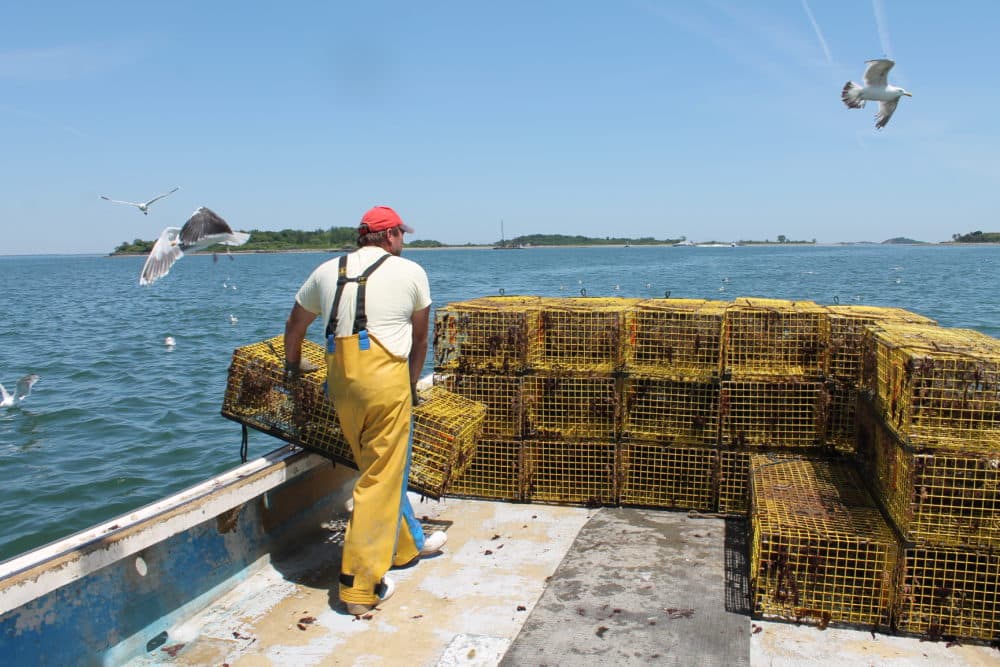Advertisement
Researchers Try To Build A Better Life Jacket To Keep Lobstermen Alive
Resume
Early on a July morning, Massachusetts lobsterman Steve Holler and his sternman Frank Lenardis haul lobster traps out of Boston Harbor over the edge of Holler's boat, the November Gale, and dump the catch into a holding tray.
Lenardis then carries the 50-pound traps to the back of the boat, stacking them on top of each other, cautious not to get his feet tangled in the rope trailing behind him.
"It's a dance between me and him," Holler says. "Him getting that done, me getting this done, because with his strength, his weight, he'll knock me right on my rear end. He's done it a few times."
Over the course of a day, they repeat the dance of hauled traps and coiled ropes 300 times.
This particular morning in July, everything goes smoothly. But Holler remembers one day in February when a routine haul went very wrong, after he discovered that a few wire traps had frozen to the dock.

"I was tugging and tugging with a hook to try and free them up," Holler says. "They did free up, and I lost my balance and started falling backwards."
Holler plunged into the freezing Boston Harbor.
"First, you're saying in a split second, 'I can't believe this is happening.' And then what sets in is, 'I've gotta get out of the water.' But your body has got a whole different idea."
Holler managed to grab the last rung of a ladder, pulling himself to safety. He said if he hadn't caught the ladder, with the weight of his winter clothes and the frigid water, he wouldn't have been able to pull himself out.
That day, moving around on the docks, Holler wasn't wearing a life jacket. Out in the middle of the water this summer day, he wasn't wearing one either.
For many lobstermen like Holler, life jackets get in the way of their work.
"[I] never even considered it," says Peter Fredrickson, captain of the No Regrets out of Hingham. Fredrickson has been fishing for more than 40 years.
"Because, you know, big, bulky life jackets — No. 1, you can't work in them, and No. 2, it's hot," he explains, "and on a day like today, to wear anything else besides shorts and a T-shirt and your rain pants is gonna be miserable."

A 16-year study from the Centers for Disease Control and Prevention's National Institute for Occupational Safety and Health found that in Massachusetts, fatal falls overboard represented 22 percent of deaths among commercial fishermen from 2000 to 2016. The state's lobster industry saw the highest number of those falls — and in every case, the lobsterman was not wearing a life jacket.
"The most frequent cause of death in the lobster fishing community is falls overboard," says Julie Sorensen, director of the Northeast Center for Occupational Health and Safety (NEC).
But Sorensen acknowledges the barriers to regular use. In addition to the heat, bulk and high costs — modern life jackets can run anywhere from $80 to $200 — some of the styles with buckles can get caught in traps, making the job even more dangerous. So she decided it was the life jackets that had to change.
"I think you need to assume that people are doing the best they can in the situations that people are living and working [in]," she says. "And that maybe what we need to do as public health researchers is make it easier and more rewarding for [people] to do the safer thing, or the healthier thing."
Sorensen launched a research project aimed at redesigning the life jackets.
The NEC Personal Flotation Device Project recruited 181 lobstermen in Massachusetts and Maine. For four to six weeks, the lobstermen wore different types and styles of jackets while working.
Both Peter Fredrickson and his son Josh, a teacher who also works as his father's sternman, participated in the study. They wore a style that clipped around their waists.
"If you lived through the '90s, it's like a fanny pack basically," Josh Fredrickson says.
The small pack has a carbon dioxide cartridge that deploys if you pull the ripcord, inflating the pack.
It's a far cry from the old orange horseshoe vests, but Peter Fredrickson told the researchers that it still isn't perfect.
"The belt loosens up and it falls off," he says. "It wasn't easy to clean and you get dirty on a lobster boat. But [overall], it worked."

Those issues and other feedback from the study were sent to the life jacket manufacturers, who are using the information to reevaluate the designs.
The researchers plan to start phase two next summer — using social media campaigns and community events to get more lobstermen and their families interested in the new jackets.
The research team may not win over everyone. While working on his boat, Holler says he might consider a design that didn't get in his way, but life jackets just aren't his main concern.
"I don't think of it that much," he says. "There [are] more hazards on the boat — I could lose fingers, I could get some serious lacerations with the knives, hand injuries, leg injuries... falling overboard is on my mind, but it's not at the very top, sadly to say."
Lenardis said everyone has a personal preference, and he will not be wearing one.
But for the Fredricksons, the study changed their minds.
"I'm gonna wear it all the time now," Peter Fredrickson says. "You know, I'm 65 years old, I get up on the gunnel [the top edge of the side of a boat] and my balance isn't what it once was, I feel like — I've never gone over the side, knock on wood, but I could, so it makes sense."
He said he hopes others will take advantage of the new jackets too, because lobstermen never think they're going overboard, until the moment they do.
This segment aired on October 9, 2018.
